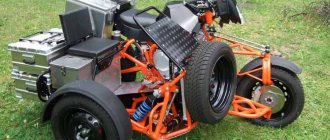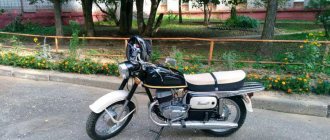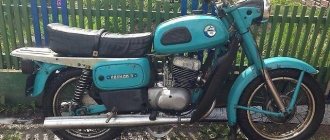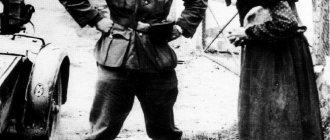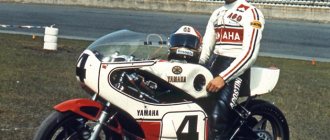More than a hundred years ago, in 1916, the construction of a plant aimed at producing rifles and machine guns was started in the city of Kovrov. The flames of the First World War were just burning, and weapons were needed at the front more than ever. A couple of years later, in the 18th, after the Bolsheviks came to power, two famous gunsmiths were sent to the plant - Fedorov and Degtyarev.
Degtyarev Vasily Alekseevich
It was named after the latter almost thirty years later and still exists under that name. And the story of how they switched to producing motorcycle products is very typical for the post-war period and is similar to the history of the Minsk plant. The country urgently needed to restore its industry, and therefore many military enterprises were transferred to peaceful lines. Thus, the building blocks for the future appearance of the legendary brand of Soviet motorcycles were laid.
Main characteristics of Voskhod 3 M
The technical characteristics of the “Voskhod Z M” are pleasantly pleasing, allowing you to take walks both on the highway and on country roads.
Length of base from wheel to wheel, 1.3 meters
| External dimensions (length/width/height), meters | 2,0/0,76/1,09 | ||||||||||||||||||||||||||||||
| Dry weight, kilograms | 122 | Engine | One cylinder for two strokes, capacity 173 cm3 | Cooling system | Air | Power on offer at 5600 rpm | 15 horsepower | Torque at 5200 rpm | Reaches 16 Nm | Speed maximum | 110 kilometers per hour | Fuel consumption, liters | 4.2 per hundred kilometers | Generator | 12 volts | Front suspension | Telescope fork, stroke—1.6 cm | Rear suspension | The pendulum at an angle of 20 degrees gave a stroke of 8.5 cm | Brake mechanism | The drums, with a diameter of 16 centimeters, had an indicator of block production | Clearance | 12.5 centimeters | Load limit | 160 kilograms | Fuel tank volume | 14 liters | checkpoint | Four-speed | Wheels | Spoked, tube tires, 16 inches |
And off we go
"Sunrise"
Published in 1965. It had a more powerful engine compared to the Kovrovets - 10 hp. This engine allowed it to accelerate to 95 km/h. He weighed 105 kg. Like its predecessor, it was distinguished by its simplicity in its design. On the one hand, this caused criticism from some motorcyclists, since the motorcycle turned out to be unsightly and simple in appearance.
Kovrovets K-125
But on the other hand, this was compensated by the fact that it could be repaired almost with improvised stones and sticks. It was wildly popular among the people; up to two hundred thousand models were produced per year! It continued to roll off the assembly line until 1971.
“Voskhod-2”
Since the previous model was a great success and did not cause any complaints, it was decided not only to refine and improve some aspects. Outwardly he became attractive, no one blamed him for his dullness anymore. It became easier to use and lasted longer. The engine was one and a half horsepower more powerful than its predecessor - 11.5. This allowed it to accelerate to 100 km/h. The fuel tank held 13 liters of fuel, and gasoline consumption at an average speed of 60 km/h was only 3 liters.
Motorcycle "Voskhod 2"
It is no wonder that he was also in demand among the people. A year later, a modernized version of Voskhod-2M appeared, which had a 14 hp engine. and can accelerate to 105 km/h.
“Voskhod-3”
The series received its next continuation in 1979. Changes affected the fuel tank, which now had a capacity of 2 liters more than its predecessor.
Expert opinion
Alexander Nikolaevich Rumyantsev
Inventor, owner of many patents, candidate of technical sciences, professor at St. Petersburg Technical University.
We installed modern brakes, updated the generator and saddle, making it more comfortable for long journeys. The wheels became stronger, which was useful in the conditions of bad Soviet roads.
The speed of movement remained at 105 km/h. And the weight increased to 125 kg.
“Voskhod-3M”
In 1983, the 3rd model was modernized, which is still considered the next generation in the series due to the number of innovations and innovations. Over the course of several years, engineers and members of the design bureau have been collecting and summarizing reviews from ordinary users about the plant’s motorcycles in order to fully satisfy the needs of Soviet motorcycle enthusiasts. We started with the appearance, since in every second letter sent to the plant, great attention was paid to this particular characteristic.
Motorcycle "Voskhod 3M"
The design has become more streamlined, models of different colors have appeared. Updated tires improved road grip. The brakes were modernized, their drive was changed, making them more reliable and wear-resistant. For the first time in the series, a factory anti-theft lock was installed. The weight of the two-wheeled friend was slightly reduced to 122 kg, but the maximum speed remained the same. The price still remained at a very affordable level, which had a significant impact on its popularity among the people.
In 1984, a limited edition luxury model was released. The outer one stood out with its chrome details. We also changed the shape and filling of the saddle, making it even more comfortable. With an engine similar in power to previous models (14 hp), it could accelerate to 115 km/h due to more modern filling. It was produced for two years, until 1986, and was in demand among collectors and big fans of the brand. The exact number of copies produced is unknown.
In 1985 they also produced models aimed at the target audience of tourists. We changed the steering wheel, making it more sports-oriented, and added a rear bag and two side bags. With a weight of 125 kg, the maximum speed was 145 km/h.
“Voskhod-ZM-01”
The series was continued in 1989, when the USSR was on the verge of collapse. What is noteworthy is that the model survived both these turbulent times and the turbulent 90s, but at the present time it is not produced.
Voskhod-3M Lux
The engine had a power of 15 hp, and the volume of gasoline consumption was reduced. It has two modernizations - “Owl” and “Courier”, but they have nothing to do with the Soviet Union.
A little magic
Although it is difficult to turn the Voskhod bike, even with the most modern tuning, into something more modern and super-powerful, nevertheless, true fans of the series still do not lose hope and tune each one in their own way. In numerous photos of “Voskhod 3 M” you can see the following modification options:
- closer to the “sport” class:
- raising the rear shock absorbers;
- change the exhaust elbow, moving it a little higher and replace the pipe diameter with a larger one;
- allows you to increase power;
- a variation of the “chopper” can be seen in the video “Voskhod 3 M”:
- the rear is lowered, the fork and wheel are replaced with wide options;
- change the angle of the front fork;
- cylinder covers are dressed in chrome;
- change the steering wheel to a “Chopper” one, and also do not forget about the instrument panel, headlights and tires;
- changing the air filter to foam elements gives the engine a boost;
- Don't forget about aerodynamics.
Engine diagram Voskhod 3m
1 – spark plug A23; 2 – cylinder head; 3 – cylinder head gasket; 4 – cylinder; 5 – piston ring; 6 – piston; 7 – piston pin; 8 – needle bearing; 9 – cylinder gasket; 10 – connecting rod; 11 – bearing lubrication channel; 12 – ball bearing; 13 – right crankshaft oil seal; 14 – right main crankshaft journal; 15 – generator; 16 – movable gear of the second gear; 17 – primary shaft with gear; 18 – main gear; 19 – gearbox and clutch housing; 20 – clutch release rod; 21 – pin of the clutch release mechanism; 22 – gearbox oil seal; 23 – reverse gear sprocket; 24 – generator cover; 25 – crankcase (right half); 26 – gear shift shaft; 27 – crankcase (left half); 28 – trigger shaft; 29 – trigger spring; 30 – trigger sector; 31 – trigger gear; 32 – trigger ratchet; 33 – kickstarter shaft oil seal; 34 – kickstarter shaft oil seal cap; 35 – kickstarter lever; 36 – gear shift lever; 37 – clutch disc; 38 – adjusting screw; 39 – internal clutch drum; 40 – leading clutch disc; 41 – outer clutch drum; 42 – left main crankshaft journal; 43 – front drive sprocket; 44 – chain PV-9.525-1300; 45 – clutch cover; 46 – left crankshaft oil seal; 47 – ball bearing; 48 – bearing lubrication channel.
Source
What is sunset
The moment when the upper edge of the Sun disappears above the edge of the sky is called sunset. Like sunrise, the actual sunset occurs later than the visual one, due to refraction. If you rise to a high place, the sunset of the luminary will be delayed for a few more minutes.
As the solar disk descends to the horizon, it changes color. At first, yellow tones predominate, then orange, and finally red.
The color of the sky changes in the same order. The sky becomes the most saturated red when the star goes 4-5° beyond the horizon. The sun's rays gradually fade away and a dimly lit strip remains.
Sunset view from the seashore
After the red wave is no longer visible, a green glow occurs. It lasts a moment. But under favorable weather conditions, the human eye is able to capture this beauty.
What is sunrise
The moment the edge of the Sun appears above the horizon is called sunrise. The sun's rays are refracted when passing through the Earth's atmosphere. Therefore, the real sunrise in moderate latitudes occurs 35 minutes later than the visual one. At the equator, this value is 4 minutes 40 seconds; at the poles, refraction (refraction) lengthens the day by almost 48 hours.
Beautiful sunrise
Rarely does an amazing phenomenon occur - the rising of a false sun. The luminary is not yet visible, but its double appears above the horizon. It seems that there is a huge lens in front of him. These are millions of ice crystals, falling down, refracting light rays.
Interesting Facts
- In ancient times, sunset symbolized death. And its red color was considered a reflection of hell.
- Eastern sages still conduct meditation rituals at sunset today. By throwing off negativity, they prepare for a new day and are charged with positive energy.
- Rising above the horizon and descending beyond it, the solar disk increases in size. But this is an optical illusion.
- Over 100 years, our planet has slowed down its rotation speed, which caused the length of the day to increase by 1.7 milliseconds.
Sunrise and sunset are the moments that define the boundaries of daylight hours. Daily observation of nature at the beginning and end of the day improves psychological health and significantly reduces stress levels. This is confirmed by scientific facts.
How to distinguish sunrise from sunset
Once a day, the Sun appears in the sky and disappears beyond the horizon. The time before sunrise and after sunset is called twilight. In temperate latitudes they last about 2 hours, at the poles - 2.5 weeks, at the equator - 20 minutes. Between twilight, night reigns on Earth.
Sunset and sunrise are two identical phenomena occurring in reverse order. You can determine what is happening now:
- according to the colors of the solar spectrum;
- by visual acuity;
- by air temperature difference.
At sunset, the sky turns deep orange or red. After all, the earth's surface, heated during the day, becomes covered with dust, which is lifted upward by air currents. The color red breaks through the dust curtain. Due to its long wavelength, it is poorly scattered in the atmosphere.
At dawn, an optical effect colors the sky in delicate shades of yellow, pink, and blue. The purest blue appears through them. The first rays sliding across the surface of our planet pass through dense and humid layers of air, cleared of dust overnight.
Visual difference between sunset and dawn
In the evening, eyes accustomed to daylight become tired. Visual acuity becomes dull. In the morning, rested or dark-adapted eyes are able to see subtle changes in nature and view a wider range of colors.
It is very difficult to determine whether the Sun is rising or setting from a photograph. It is impossible to record a color change with 100% accuracy. And the terrain makes its own adjustments. The desert adds brown shades, the forest belt adds green. The sea sunset is especially beautiful.
Before dawn there is a decrease in air temperature.
Where does the sun rise and where does it set?
The globe rotates around its axis. It seems to people that the Sun moves in the direction from north to south. In fact, all planets revolve around the sun. The sunset and sunrise points shift every day. The length of the day also changes with the time of year and directly depends on the trajectory of the star.
The Sun sets due in the west and rises due in the east on the days of the autumn and spring equinoxes. After the March equinox, sunrise begins north of east and sunset begins north of west. After the September equinox, the days become shorter and the solar disk moves into the northern hemisphere.
On the day of the summer solstice, the morning dawn rises at the maximum point of the northeast. This is the longest day of the year.
Diagram of the movement of the Sun across the sky


